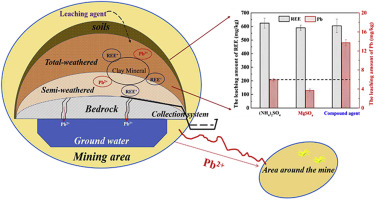当前位置:
X-MOL 学术
›
Ecotox. Environ. Saf.
›
论文详情
Our official English website, www.x-mol.net, welcomes your
feedback! (Note: you will need to create a separate account there.)
Study on Pb release by several new lixiviants in weathered crust elution-deposited rare earth ore leaching process: Behavior and mechanism.
Ecotoxicology and Environmental Safety ( IF 6.2 ) Pub Date : 2020-01-02 , DOI: 10.1016/j.ecoenv.2019.110138 Jiyang Qiao 1 , Jie Tang 1 , Qiang Xue 1
Ecotoxicology and Environmental Safety ( IF 6.2 ) Pub Date : 2020-01-02 , DOI: 10.1016/j.ecoenv.2019.110138 Jiyang Qiao 1 , Jie Tang 1 , Qiang Xue 1
Affiliation

|
New leaching agents could lead to a reduction in ammonia nitrogen pollution and the supplementation of soil nutrients during in-situ mining. They could also result in the release of even more toxic heavy metals, which has an impact on the environment as well as human health. In this study, column leaching experiments were used to simulate in-situ leaching, and the leaching behavior and fractional changes of lead in weathered crust elution-deposited rare earth ore by different leaching agents were studied. The experimental results showed that the amount of lead that was leached followed the order of CLA (60% CaCl2 + 25% NH4Cl + 15% MgSO4) > (NH4)2SO4 > MgSO4. The lead leaching process was comprised of both an acceleration and deceleration stage that followed the first order kinetic model. The amount of Pb when using compound agent was the greatest most likely because of the presence of Cl-. The soil heavy metal morphology test showed that the three leaching agents primarily leached acid extractable lead, and the compound leaching agent leached the greatest amount of acid extractable Pb, which mainly due to the presence of NH4Cl. The reducible fraction was enriched in the direction of migration of the leachate, which was due to the presence of SO42-. These results indicate that the introduction of leaching agents during the mining process pose a greater risk for the release of heavy metals and provide a theoretical basis for the prevention and remediation of heavy metal pollution in mining areas where new leaching agents were used.
中文翻译:

风化壳溶出稀土矿浸出过程中几种新毒物释放铅的行为和机理研究。
新的浸出剂可减少原位采矿过程中氨氮污染并补充土壤养分。它们还可能导致释放出毒性更大的重金属,从而对环境以及人类健康产生影响。在这项研究中,使用柱浸出实验来模拟原位浸出,并研究了不同浸出剂对风化硬壳洗脱沉积稀土矿石中铅的浸出行为和分数变化。实验结果表明,浸出的铅量遵循CLA的顺序(60%CaCl2 + 25%NH4Cl + 15%MgSO4)>(NH4)2SO4> MgSO4。铅浸出过程包括遵循一级动力学模型的加速和减速阶段。由于存在Cl-,使用复合剂时Pb的量最大。土壤重金属形态测试表明,三种浸出剂主要浸出酸可萃取铅,复合浸出剂浸出最大量的酸可萃取铅,这主要是由于NH4Cl的存在。由于存在SO42-,可还原级分在渗滤液的迁移方向上富集。这些结果表明,在采矿过程中引入浸出剂对重金属的释放具有更大的风险,并为使用新浸出剂的矿区预防和修复重金属污染提供了理论基础。土壤重金属形态测试表明,三种浸出剂主要浸出酸可萃取铅,复合浸出剂浸出最大量的酸可萃取铅,这主要是由于NH4Cl的存在。由于SO42-的存在,可还原级分在渗滤液的迁移方向上富集。这些结果表明,在采矿过程中引入浸出剂对重金属的释放具有更大的风险,并为使用新浸出剂的矿区预防和修复重金属污染提供了理论基础。土壤重金属形态测试表明,三种浸出剂主要浸出酸可萃取铅,复合浸出剂浸出最大量的酸可萃取铅,这主要是由于NH4Cl的存在。由于存在SO42-,可还原级分在渗滤液的迁移方向上富集。这些结果表明,在采矿过程中引入浸出剂对重金属的释放具有更大的风险,并为使用新浸出剂的矿区预防和修复重金属污染提供了理论基础。由于存在SO42-,可还原级分在渗滤液的迁移方向上富集。这些结果表明,在采矿过程中引入浸出剂对重金属的释放具有更大的风险,并为使用新浸出剂的矿区预防和修复重金属污染提供了理论基础。由于存在SO42-,可还原级分在渗滤液的迁移方向上富集。这些结果表明,在采矿过程中引入浸出剂对重金属的释放具有更大的风险,并为使用新浸出剂的矿区预防和修复重金属污染提供了理论基础。
更新日期:2020-01-02
中文翻译:

风化壳溶出稀土矿浸出过程中几种新毒物释放铅的行为和机理研究。
新的浸出剂可减少原位采矿过程中氨氮污染并补充土壤养分。它们还可能导致释放出毒性更大的重金属,从而对环境以及人类健康产生影响。在这项研究中,使用柱浸出实验来模拟原位浸出,并研究了不同浸出剂对风化硬壳洗脱沉积稀土矿石中铅的浸出行为和分数变化。实验结果表明,浸出的铅量遵循CLA的顺序(60%CaCl2 + 25%NH4Cl + 15%MgSO4)>(NH4)2SO4> MgSO4。铅浸出过程包括遵循一级动力学模型的加速和减速阶段。由于存在Cl-,使用复合剂时Pb的量最大。土壤重金属形态测试表明,三种浸出剂主要浸出酸可萃取铅,复合浸出剂浸出最大量的酸可萃取铅,这主要是由于NH4Cl的存在。由于存在SO42-,可还原级分在渗滤液的迁移方向上富集。这些结果表明,在采矿过程中引入浸出剂对重金属的释放具有更大的风险,并为使用新浸出剂的矿区预防和修复重金属污染提供了理论基础。土壤重金属形态测试表明,三种浸出剂主要浸出酸可萃取铅,复合浸出剂浸出最大量的酸可萃取铅,这主要是由于NH4Cl的存在。由于SO42-的存在,可还原级分在渗滤液的迁移方向上富集。这些结果表明,在采矿过程中引入浸出剂对重金属的释放具有更大的风险,并为使用新浸出剂的矿区预防和修复重金属污染提供了理论基础。土壤重金属形态测试表明,三种浸出剂主要浸出酸可萃取铅,复合浸出剂浸出最大量的酸可萃取铅,这主要是由于NH4Cl的存在。由于存在SO42-,可还原级分在渗滤液的迁移方向上富集。这些结果表明,在采矿过程中引入浸出剂对重金属的释放具有更大的风险,并为使用新浸出剂的矿区预防和修复重金属污染提供了理论基础。由于存在SO42-,可还原级分在渗滤液的迁移方向上富集。这些结果表明,在采矿过程中引入浸出剂对重金属的释放具有更大的风险,并为使用新浸出剂的矿区预防和修复重金属污染提供了理论基础。由于存在SO42-,可还原级分在渗滤液的迁移方向上富集。这些结果表明,在采矿过程中引入浸出剂对重金属的释放具有更大的风险,并为使用新浸出剂的矿区预防和修复重金属污染提供了理论基础。











































 京公网安备 11010802027423号
京公网安备 11010802027423号